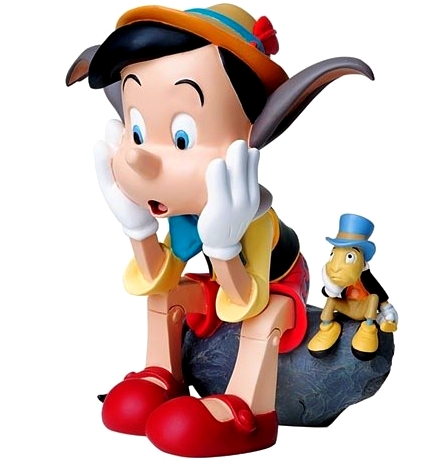
Jiminy is a figure of friendship, steadfastness, and warmth, and his design reflects that, from his big, trusting eyes to his perpetually forward-leaning posture. Just as with Pinocchio, the answer lay not in what the character physically represents, but how audiences should respond to that character. There’s nothing particularly insect-like about the finalized Jiminy, outside of the broad planes of his face-even his antennae look more like hair than a piece of insect anatomy-but it took Kimball several attempts to land there. Jiminy Cricket provided a separate challenge for animator Ward Kimball, whom Disney tasked with creating a cute, lovable sidekick out of what Kimball initially saw as “an ugly insect.” In retrospect, it’s fairly astonishing that Disney and Kimball were able to take a creepy, moralizing minor character from Collodi’s story-one Pinocchio kills with a mallet-and turned him into the company’s first and most durable animal sidekick, one who functioned as the Walt Disney Company’s secondary mascot (after Mickey) for years. Kahl’s model for the character eventually became the little wooden-head we all know and love today. It was animator Milt Kahl who focused on drawing Pinocchio as a little boy rather than a puppet, with only his nose and angular posture indicating his wood-carved origins. He halted production to reconfigure his star. Disney was unhappy with early attempts at the character, which he felt were too puppet-like and unrelatable.

had to find a way to make him visually appealing as well.
#JIMINY CRICKET 3D RENDERING SERIAL#
In Carlo Collodi’s original Italian serial novel, Pinocchio was a mean-spirited wooden boy, which meant that in addition to altering his personality to that of an impressionable wide-eyed naif, Disney and Co. Pinocchio himself was the first and greatest challenge of character design. Disney shorts had a long history of non-humanoid characters, but blowing that kind of design up to feature-sized and -length proportions meant Walt Disney and his team of artists had to think beyond what the characters were supposed to represent, and consider what emotional effect they would have on the audience. That wasn’t the case with Pinocchio, which adds a wooden puppet, a cricket sidekick, magical donkey-boys, and some animal-kingdom flim-flam men to its otherwise-human cast.

“Little wooden head, go play your part, bring a little joy to every heart.”Īs memorable as Snow White’s character design is-particularly in its discrete, distinguishable seven dwarves-all of its acting characters are humanoid, which meant animators could reference human models, or even themselves, when animating their movement.

It’s a lush, expensive labor of love that found Disney and his animators-including the young whippersnappers who went on to become the company’s storied “Nine Old Men”-developing and refining the techniques that would define Disney, and in many cases non-Disney, animation for years to come.Īnd so, as we approach Pinocchio’s 75th anniversary next February, let’s take a look back at some of the achievements, innovations, and techniques that set the standard Disney has worked to meet ever since-and arguably never has. But Pinocchio was and is the true marvel of Disney Feature Animation’s first half-decade. And the years immediately following its successful release involved a flurry of activity for the company that resulted in a string of early classics, including Fantasia, Dumbo, and Bambi, which were all released within a year of one another. Which isn’t to say Snow White wasn’t an artistic achievement of monumental proportions-it was and will always be the first cel-animated feature, and the chutzpah and innovation required to make it happen cannot be understated. (A 1992 re-release made considerably more, but by that time the film had already been entrenched as a classic in the popular imagination.) But creatively, Pinocchio represents the apex of the Disney Feature Animation brand, a project of wild ambition that consumed Walt Disney and his team for two years, and firmly established feature animation as a legitimate art form on the same level as traditional filmmaking. The 1940 follow-up to Walt Disney’s world-beating Snow White And The Seven Dwarfs-which proved in 1937 that feature-length animated movies were not only possible, but could be profitable as well- Pinocchio cost more than twice as much as its predecessor, and made back only half its production costs in its initial theatrical run.


 0 kommentar(er)
0 kommentar(er)
